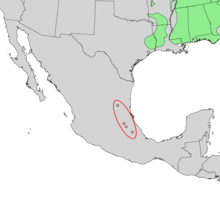Fagus mexicana
Fagus mexicana, the Mexican beech or haya, is a species of beech endemic to northeastern and central Mexico, where it occurs from southwest Tamaulipas south to Hidalgo and Puebla. It is restricted to high altitude cloud forests in the Sierra Madre Oriental.[1][2]
| Fagus mexicana | |
|---|---|
| Scientific classification | |
| Kingdom: | Plantae |
| Clade: | Tracheophytes |
| Clade: | Angiosperms |
| Clade: | Eudicots |
| Clade: | Rosids |
| Order: | Fagales |
| Family: | Fagaceae |
| Genus: | Fagus |
| Species: | F. mexicana |
| Binomial name | |
| Fagus mexicana Martínez | |
 | |
| Natural range of Fagus grandifolia subsp. mexicana in red (subsp. grandifolia in green) | |
It is closely related to the American beech Fagus grandifolia and is usually treated as Fagus grandifolia subsp. mexicana (Martínez) E.Murray.[3][4][5][6]
Description
Fagus mexicana is a deciduous tree, reaching heights of 25–40 m tall and up to 1 m trunk diameter. The leaves are alternate and simple, with a slightly toothed margin, usually smaller than those of American beech, 5–8 cm long and 3–5 cm broad. The buds are long and slender, 15–25 mm long and 2–3 mm thick.
The flowers are small catkins which appear shortly after the leaves in spring. The seeds are small triangular nuts 15–20 mm long and 7–10 mm wide at the base; there are two nuts in each cupule, maturing in the autumn 6–7 months after pollination.
References
- Oswaldo Téllez-Valdés, Patricia Dávila-Aranda, Rafael Lira-Saade (2006) "The effects of climate change on the long-term conservation of Fagus grandifolia var. mexicana, an important species of the Cloud Forest in Eastern Mexico," Forest Diversity and Management, (Vol. 2 of Topics in Biodiversity and Conservation), Springer Netherlands, pp. 35-47
- Williams-Linera, Guadalupe; Devall, Margaret S.; Alvarez-Aquino, Claudia (2000). "A Relict Population of Fagus grandifolia var. mexicana at the Acatlan Volcano, Mexico: Structure, Litterfall, Phenology and Dendroecology". Journal of Biogeography. 27 (6): 1297–1309. doi:10.1046/j.1365-2699.2000.00500.x. JSTOR 2656078.
- Ernesto, Ch. Rodríguez-Ramírez; Sánchez-González, Arturo; Ángeles-Pérez, Gregorio (2013). "Current distribution and coverage of Mexican beech forests Fagus grandifolia subsp. mexicana in Mexico" (PDF). Endangered Species Research. 20 (3): 205–216. doi:10.3354/esr00498.
- "Fagus grandifolia subsp. mexicana". Germplasm Resources Information Network (GRIN). Agricultural Research Service (ARS), United States Department of Agriculture (USDA). Retrieved 19 January 2018.
- CONABIO. 2009. Catálogo taxonómico de especies de México. 1. In Capital Nat. México. CONABIO, Mexico City. cited by Tropicos.org. Missouri Botanical Garden. 13 Dec 2013
- Williams-Linera, Guadalupe; Rowden, Adèle; Newton, Adrian C. (2003). "Distribution and stand characteristics of relict populations of Mexican beech (Fagus grandifolia var. mexicana)". Biological Conservation. 109: 27–36. doi:10.1016/S0006-3207(02)00129-5.